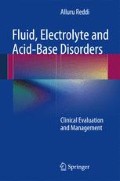Abstract
Hypercalcemia is defined as serum [Ca2+] > 11 mg/dL or 1 mg/dL above the normal range. It is a common electrolyte disorder that is frequently encountered by the primary care physicians. Hypercalcemia affects multiple organs in the body, including the kidney, heart, brain, peripheral nerves, and the gut. Although causes of hypercalcemia are varied, they fall into four major categories: (1) hypercalcemia secondary to increased Ca2+ mobilization from the bone; (2) hypercalcemia due to increased absorption of Ca2+ from the gastrointestinal tract (GI); (3) hypercalcemia due to decreased urinary excretion of Ca2+, and (4) hypercalcemia due to medications.
Access this chapter
Tax calculation will be finalised at checkout
Purchases are for personal use only
Reference
Bilezikian JP, Khan AA, Potts JT Jr, on behalf of the Third International Workshop on the Management of Asymptomatic Primary Hyperthyroidism. Guidelines for the management of asymptomatic primary hyperparathyroidism: summary statement from the third international workshop. J Clin Endocrinol Metab. 2009;94:335–9.
Suggested Reading
Hariri A, Mount DB, Rastegar A. Disorders of calcium, phosphorus, and magnesium metabolism. In: Mount DB, Sayegh MH, Singh AJ, editors. Core concepts in the disorders of fluid, electrolytes and acid-base balance. New York: Springer; 2013. pp. 103–46.
Heras-Herzig A, Guise TA. Disorders of calcium metabolism. In: Alpern RJ, Hebert SC, editors. Seldin and Giebisch’s The Kidney. Physiology and pathophysiology. 4th ed. Amsterdam: Elsevier; 2008. pp. 1911–44.
Hoorn EJ, Zietse R. Disorders of calcium and magnesium balance: a physiology-based approach. Pediatr Nephrol Berlin. 10 November 2012. 2012. DOI 10.1007/s00467-012-2350-2, pp. 1–12.
Smogorzewski MJ, Rude RK, Yu ASL. Disorders of calcium, magnesium, and phosphate balance. In: Taal MW, Chertow GM, Marsden PA, et al., editors. Brenner & Rector’s The Kidney. 9th ed. Philadelphia: Saunders; 2012. pp. 689–725.
Wysolmerski JJ. Parathyroid hormone-related protein: an update. J Clin Endocrinol Metab. 2012;97:2947–56.
Stewart AF. Hypercalcemia associated with cancer. N Engl J Med. 2005;352:373–8.
Author information
Authors and Affiliations
Corresponding author
Rights and permissions
Copyright information
© 2014 Springer Science+Business Media New York
About this chapter
Cite this chapter
Reddi, A. (2014). Disorders of Calcium: Hypercalcemia. In: Fluid, Electrolyte and Acid-Base Disorders. Springer, New York, NY. https://doi.org/10.1007/978-1-4614-9083-8_19
Download citation
DOI: https://doi.org/10.1007/978-1-4614-9083-8_19
Published:
Publisher Name: Springer, New York, NY
Print ISBN: 978-1-4614-9082-1
Online ISBN: 978-1-4614-9083-8
eBook Packages: MedicineMedicine (R0)

